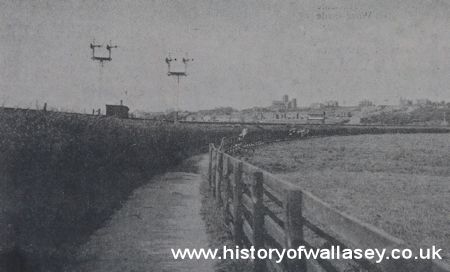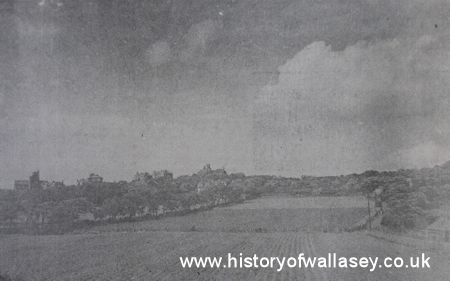Bidston Footpath was old Wallasey’s best-loved walk. It was Wallasey’s backdoor entrance to wide fields and a vast green hill. Every child knew it well. It was tramped by generations by generations of picnickers. It stood for pleasure, for open air, for freedom and fun. It led to colour and lazy summer days, to heathland and honeysuckle, to the smell of hay and the scent of flowers. The town had a great affection for it.
In the long days of summer it was heavy with hawthorn and thick in wild flowers. Its ditches were deep.
The straggling track climbed towards nearly 100 acres of open land, where heather made a purple sea, broken by clumps of bright yellow gorse.
It started just off Breck Road. Its entrance was almost hidden from the passer-by.
Wallasey liked it that way. It was a bit secretive about it. The path was a pleasure few strangers to the district were introduced to.
Bidston itself was in the old days one of the delights of Wirral. Woodpeckers nested in its woods. There were squirrels and foxes.
There was Tom o’ Shanter’s Cottage on the eastern slope of the Hill, thatched and gabled.
 |
Nearly a century ago, Bidston Footpath looked like this. Breck Road is in the background. The path and field were later covered by the Bidston Dock railway sidings. |
The windmill on the summit, built in the 1700s, looked out across the whole of North Wirral, stretching away to Grange Hill, and beyond that towards the outline of the Welsh hills.
Up to 1908 Bidston Lighthouse shone forth as a guide to shipping entering the Port of Liverpool.
The Observatory, built in 1866, housed vast and complicated machinery, and the electrical control that fired the one o’ clock gun on the Morpeth Dock, Birkenhead.
Bidston Footpath had a history that took in smugglers, contraband and the press gang. It was at one time the only safe way across a treacherous moss.
Old records show that several centuries ago contraband was temporarily hidden in Mother Redcap’s, down on the Wallasey shore, and then removed later secretly across the moor, round the then small village of Liscard.
The dead-of-night smugglers went along a lane (now Wallasey Road) and then along Bidston Footpath to the Moss, where the road ended.
The path to Bidston was difficult and dangerous. Many who attempted to cross the Moss without a guide became fog foundered.
The Moss remained un-drained until the making of Birkenhead docks in the 1840s. It was full of cross-pools, morasses and long, winding inlets.
At one dangerous point there was a pair of whale’s jawbones laid across the water. With rude crossbeams formed of trees stems, these formed a bridge. There were no posts or rails. The jawbones had to be found almost by instinct.
 |
Bidston Footpath is on the right, taken from the railway line and looking towards the Breck. Mossdene and Westbourne Roads were built on the two fields. Mosslands Drive now cuts across the centre of the picture |
The spot rumoured to have its ghosts. Many local residents would not cross the Moss, particularly the jawbones, where it was said that two people had drowned and haunted the area.
The old tale was fostered and spread by the smuggling men. The place was for years known as ‘the jawbones’.
Eerie-looking and dark, the jawbones decayed and fell into the Moss many, many years ago.
After crossing the jawbones a track led to the left towards Wallasey Pool, and to an old farmstead known as Hannah Mutches’ Farm.
The old farm was the haunt of the contraband fraternity and a hiding place for men trying to avoid the press gang.
Sailors escaped to the farm from Mother Redcap’s. The farm was surrounded by a moat.
From the jawbones (the general gathering place) a track led towards Bidston along which contraband was taken sometimes and delivered at the Ring o’ Bells. The farm to the west of Bidston Church was formerly the Ring o’ bells Inn.
When it was reported that it was not safe to proceed to Bidston, contraband was diverted to the westward along the edge of the Moss and taken to the old Saughall windmill.
The windmill stood entirely by itself, a little way from the edge pf the Moss but a full mile away from the village of Saughall Massie.
Many stories have been told of tricks played by the local smugglers on the customs and excise men. Old Mother Redcap’s comes into most of them.
On one occasion a ship with tobacco on board was wrecked on the coastline. Watching officers saw two men run from the wreck and along the beach, carrying two small bales.
A chase started. When the men were caught the packages they carried were found to contain cabbage leaves and ferns.
In the meantime, their friends had made free with the real tobacco in the wreck.
Bidston Footpath, the Moss, smugglers, the press gang and Mother Redcap’s – all are closely intertwined in the history of the 1700s.
Cut for Wallasey of 100 and 110 years the footpath meant simple pleasure, summer outings, and picnic meals of cold tea, carefully carried in white enamel jugs, and cakes and sandwiches.
The track just off Breck Road would its way to heather and gorse, clumps of silver birch, and pine and beech trees.
There were old stone walls and pretty cottages. There was a sense of space, and an atmosphere of peace.
Bidston Pathway was known by the whole town. It was mostly used when the parish was young, when pleasures were simple, and when summers seemed long and certain.
Featured sites
- Non Gamstop Casinos
- Casino Not On Gamstop
- UK Casinos Not On Gamstop
- Non Gamstop Casinos UK
- Sites Not On Gamstop
- Sites Not On Gamstop
- Casinos Not On Gamstop
- Casinos Not On Gamstop
- Casinos Not On Gamstop
- Non Gamstop Casino UK
- Casinos Not On Gamstop
- Non Gamstop Casino
- UK Online Casinos Not On Gamstop
- UK Online Casinos Not On Gamstop
- Non Gamstop Casinos
- Casino Sites Not On Gamstop
- Casinos Not On Gamstop
- Casinos Not On Gamstop
- Best Betting Sites
- Casinos Not On Gamstop
- Gambling Sites Not On Gamstop
- Betting Sites That Are Not On Gamstop
- Non Gamstop Casinos UK
- UK Online Casinos Not On Gamstop